Queensland's Navy : The Queensland Marine Defence Force
By Simon Miller, Library Technician, State Library of Queensland | 19 September 2016
Many will not be aware that prior to Federation Queensland maintained its own naval defence forces consisting of two gunboats and sundry other vessels and a force of several hundred trained officers and crew, mainly part time volunteers.
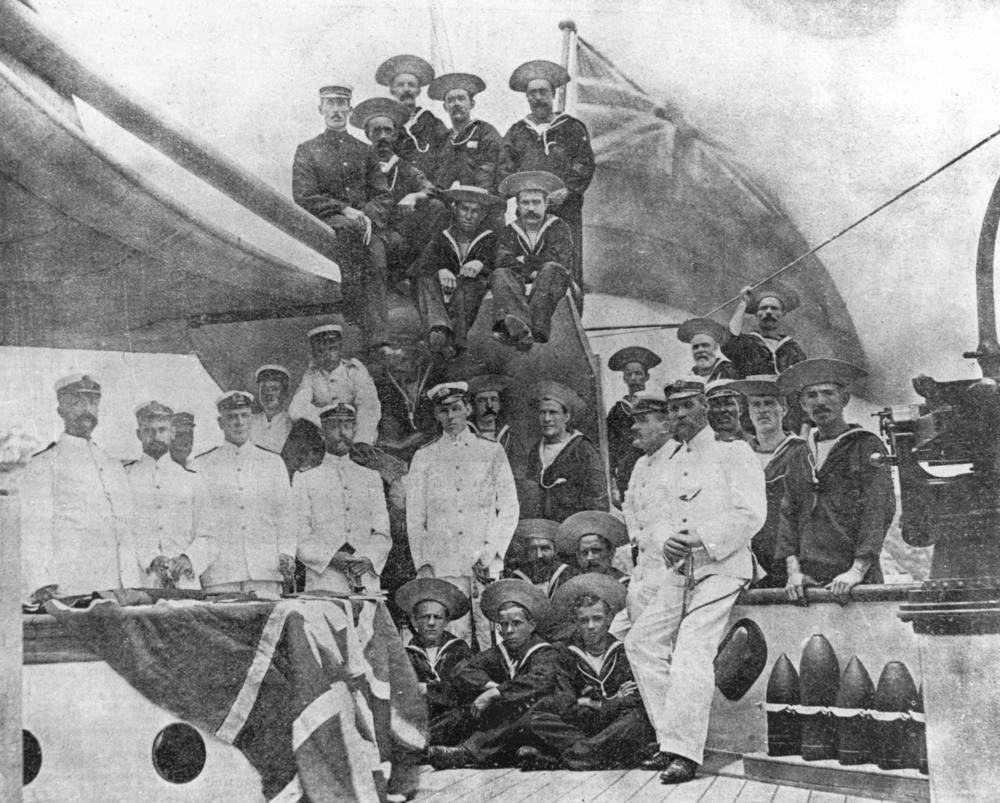
When Queensland became a separate colony in 1859 one of the first thoughts of Governor Bowen, who had some naval training himself, was to the defence of the the colony. By 1860 several volunteer rifle companies were formed, and rifle clubs were soon established to help in training the volunteers. Bowen was not in favour of a local naval force, however, believing that the colony would be best served by relying on the Royal Navy for protection of the coasts. By the 1880s there had been a number of alarms about the possibility of attacks by foreign vessels of the French, Germans and particularly the Russians. This report in The Capricornian of 1880 emphasises the danger of attacks by Russian privateers.
The active preparations in progress for the creation of a Russian privateer fleet is a direct menace to Great Britain, and they cannot be allowed to continue without some recognition by the British Government. If Russia cannot be prevented from building vessels for privateer service and encouraging her subjects to find the men and money in readiness to man and fit out such vessels in the event of hostilities breaking out between that Power and Great Britain, some measures should promptly be taken to place our ports and mercantile marine in an effective condition to meet the threatened danger. The action being taken by Russia to secure a large shipyard in the Japanese port of Nagasaki, has an indirect bearing on the same subject. ... The privateering system would be a great danger to these colonies, and some precautions should be taken against it in time of peace which would be available on the outbreak of war.
In April 1882 a report by Sir William Jervois on a Scheme of Defence for Brisbane and Moreton Bay was presented to the Queensland Parliament. This report called for 'the anchorage at Moreton Bay to be protected by a gunboat and one or more torpedo boats ...' and 'a gun vessel provided which, in time of peace would be utilized for general Governmental purposes ...'. In November 1882 Archibald Archer, the Colonial Treasurer, moved that funds be allocated for the purchase of two gunboats at a cost of £60,000 and orders were placed for the construction of the gunboats with Mitchell and Co. of Newcastle-on-Tyne. The two gunboats would be named Gayundah (a word for 'lightning' from the Wakka Wakka language from the Burnett region) and Paluma ('thunder' from the Nyawaygi language of the Townsville area) and, once delivered, would form the mainstay of the Queensland Marine Defence Force.
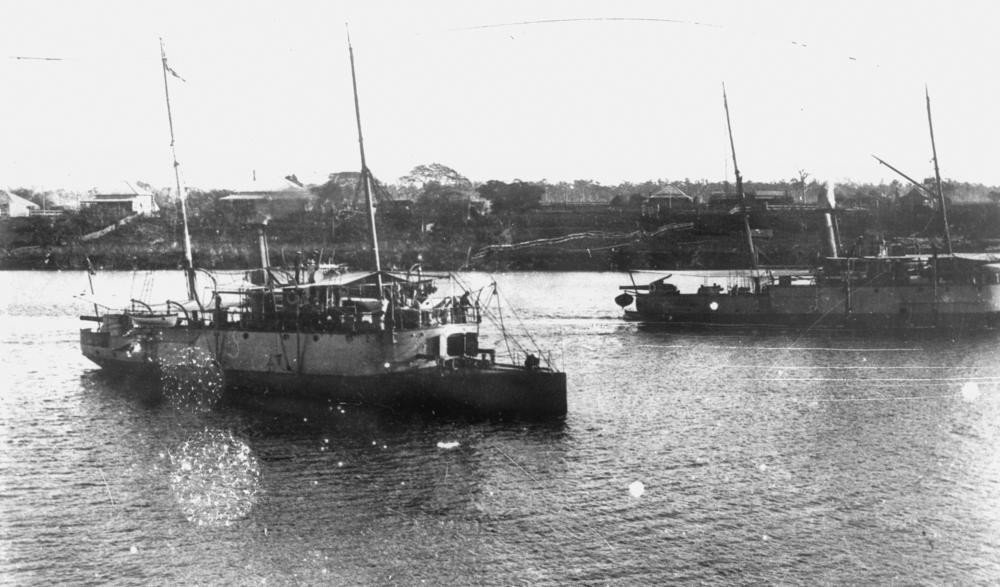
The two gunboats on the river at Bundaberg, Queensland, ca. 1898, John Oxley Library, State Library of Queensland Neg: 7880
The gunboats were launched in 1884 and the Paluma was immediately lent to the Admiralty for 10 years to undertake survey work in northern Australian waters, her big guns being shipped separately and the space being used for a chart room. The Gayundah arrived in Brisbane on March 28, 1885 and local reporters, while impressed with the vessel's weaponry and capablillities, were less than impressed with the aesthetic appeal of the gunboat. A report in The Week concentrates on the martial aspects of the new acquisition.
The nucleus of the Queensland navy is now anchored in the Garden reach. She is a nuggety specimen of those naval warriors so inalienably associated with English naval history. To an eye possessing any regard for symmetry or grace, the Gayundah is not particularly attractive; she looks anything but that meek and mild and peaceful "painted ship upon a painted ocean." Making allowance for the want of paint consequent upon a long sea voyage, the Gayundah presents the appearance of any other gunboat—a rouse-me-if-you-dare kind of look; possessing a bow, across the nose of which is stamped "audacity." A stern part, expressing "I'm ready to bless with a parting shot at any time," and a tout ensemble of cool indifference, great determination, and a general thicksetness.
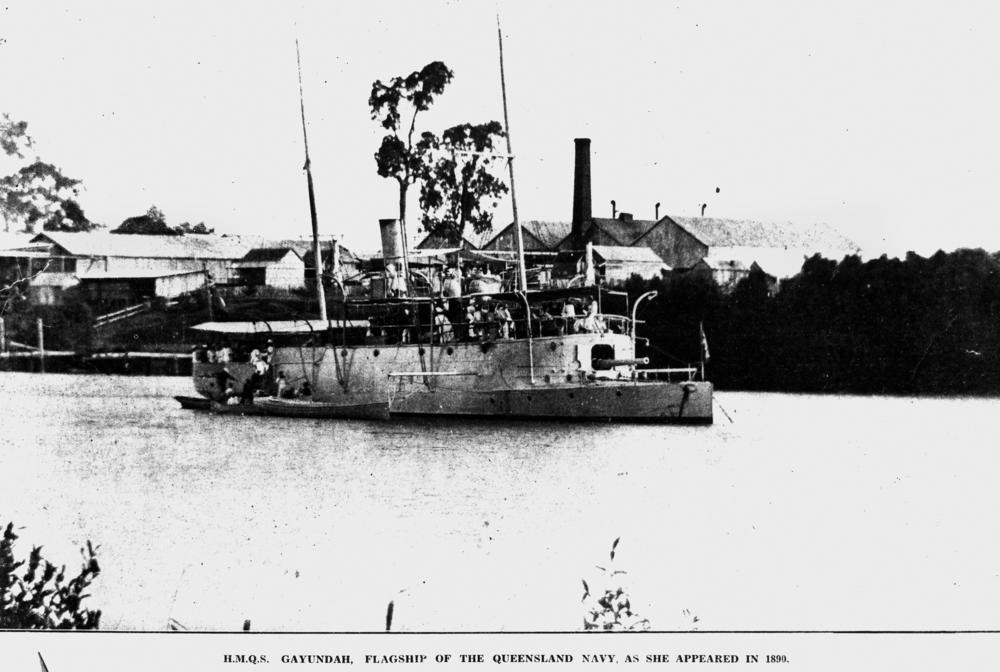
Gayundah, flagship of the Queensland Navy, as she appeared in 1890, John Oxley Library, State Library of Queensland Neg: 181456
The Brisbane Courier is even less flattering regarding the appearance of the gunship.
THIS gunboat, the first of Queensland's projected navy, arrived in the river yesterday, and cast anchor in the Garden Reach about 2 o'clock in the afternoon. A very ugly craft she is to look at, with none of the trimness of fine lines one naturally associates with vessels of her Britannic Majesty's Navy. Of course it is understood that the days of majestic beauty and symmetry have for ever departed from the Royal Navy, and in their stead utility reigns supreme, but nevertheless some of the British ironclads in their severe simplicity of outline possess a terrible beauty of their own. These remarks are, however, by no means applicable to the Gayundah. Viewed from the water she is ugly enough in all conscience in appearance. A two-masted vessel painted a grayish colour with a dirty yellow funnel springing from amidships, she strikes the eye at once as being something out of the run of ordinary craft, so that one is tempted to ask "What sort of a vessel is that?" and on being told that she is a gunboat, all wonder ceases, for to gunboats and hopper barges alike is granted the privilege of assuming shapes quite contrary to the generally received idea of what a symmetrical vessel ought to be.
... As a vessel for river service, or assisting troops on land, she would be invaluable, but her shrift would be short if she came within the range of a modem ironclad, for an 18-ton gun would blow her clean out of the water It is true that on the occasion of our visit everything was in confusion, as she had just arrived in port, and doubtless after a few days at anchor she will look more trim and neat after her long voyage, but still the long and the short of it is that she is an excessively ugly craft, both inside and out, although on the principle of a bulldog – the uglier the better - she may turn out of considerable service in time of war. She will only be able to use one gun at a time, and consequently will be of little account in the face of a heavily armed enemy. But, nevertheless, she is the nucleus of what may in the future be a powerful navy, and as such should be admired and respected by all true Queenslanders.
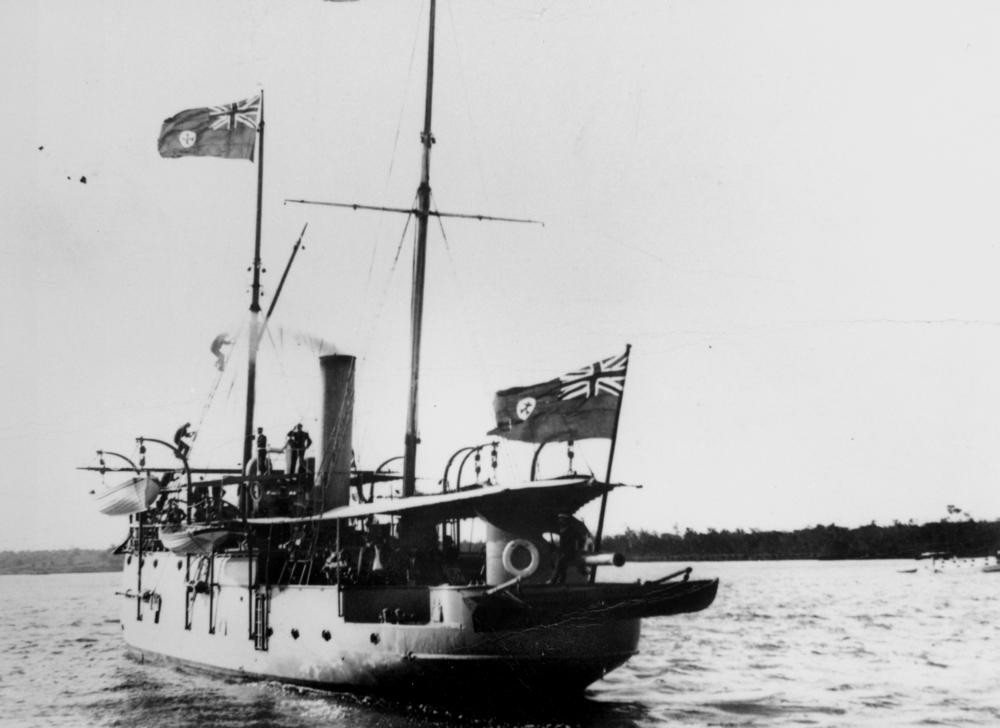
H.M.Q.S. Gayundah showing her rear mounted 6 inch gun and proudly flying the Queensland Blue Ensign, John Oxley Library, State Library of Queensland Neg: 162278
Gayundah was a modern vessel, quite heavily armed, with an 8 inch, 12 ton, breach loading, Armstrong gun at the front and a 6 inch, breach loading gun on a rotating platform at the rear. The limited movement of the forward gun could have been a problem as the Courier report suggests with only one gun being able to used on any target at a time, but as the Queensland gunboats were never engaged in any belligerent action, it is not possible to judge how effective they may have been.
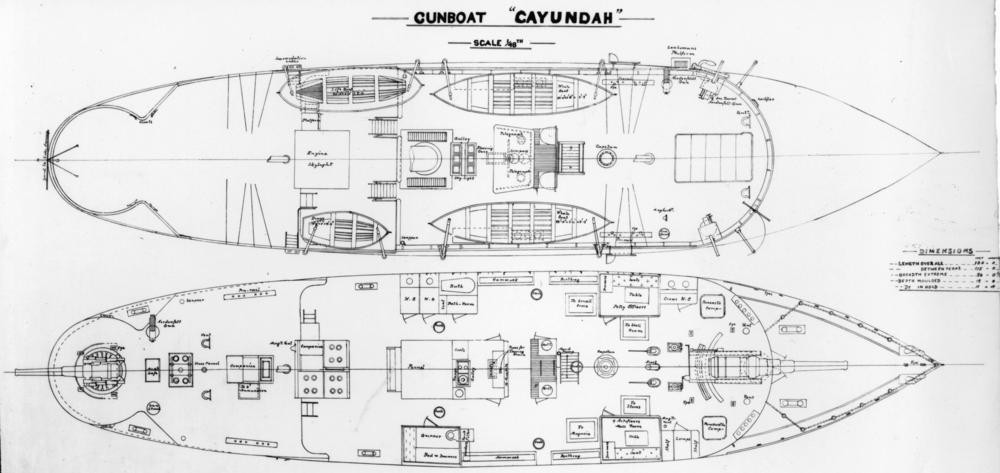
Gayundah was not the first vessel to arrive for service with the Marine Defence Force with the torpedo boat Mosquito, which, although launched after the two gunboats, arrived earlier, having been shipped aboard a commercial steamship rather than making the journey under her own steam. Mosquito was a 35 ton vessel armed with 14 inch torpedos. The boat did not have crew accommodation on board, being housed in a shed on the Brisbane River and crewed as required.
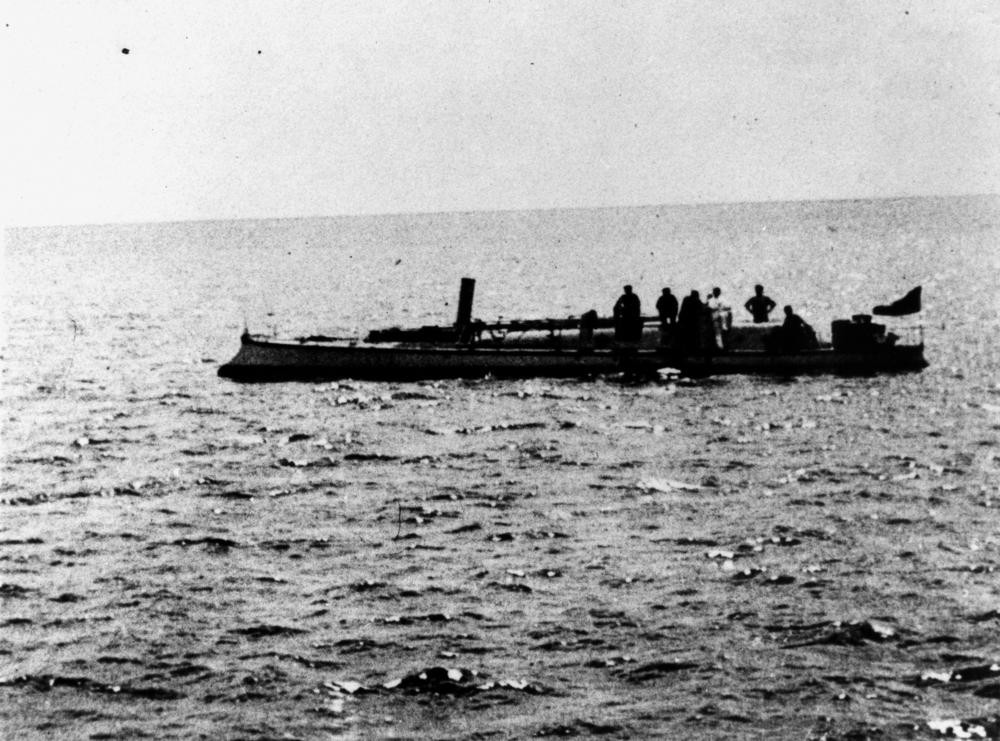
Torpedo boat Mosquito, John Oxley Library, State Library of Queensland Neg: 17283
Sadly the reputation of the Queensland Marine Defence Force was tarnished by a dispute between the Queensland Government and Queensland's Senior Naval Officer, Captain Henry Townley Wright. At the time of his appointment in 1884 Captain Wright was an undischarged bankrupt but was employed by the Queensland Government on the understanding that the bankruptcy would be discharged once certain complications had been resolved. By late 1887, Wright was still bankrupt and he had drawn various cheques for travelling expenses and entertainment and may have appropriated government stores for his own use. In October 1888, with only a few weeks left of his appointment, Captain Wright was in a heated dispute with the government over his pay. The matter was complicated because the Gayundah, of which Wright was commander, as well as being in charge of the whole Marine Defence Force, had been placed under command of the Australian Squadron of the Royal Navy. This was done in the interests of naval cooperation in the Australian Colonies and it had been a source of pride that Gayundah was the first ship of the colonial navies to have the honour of flying the White Ensign of the Royal Navy.
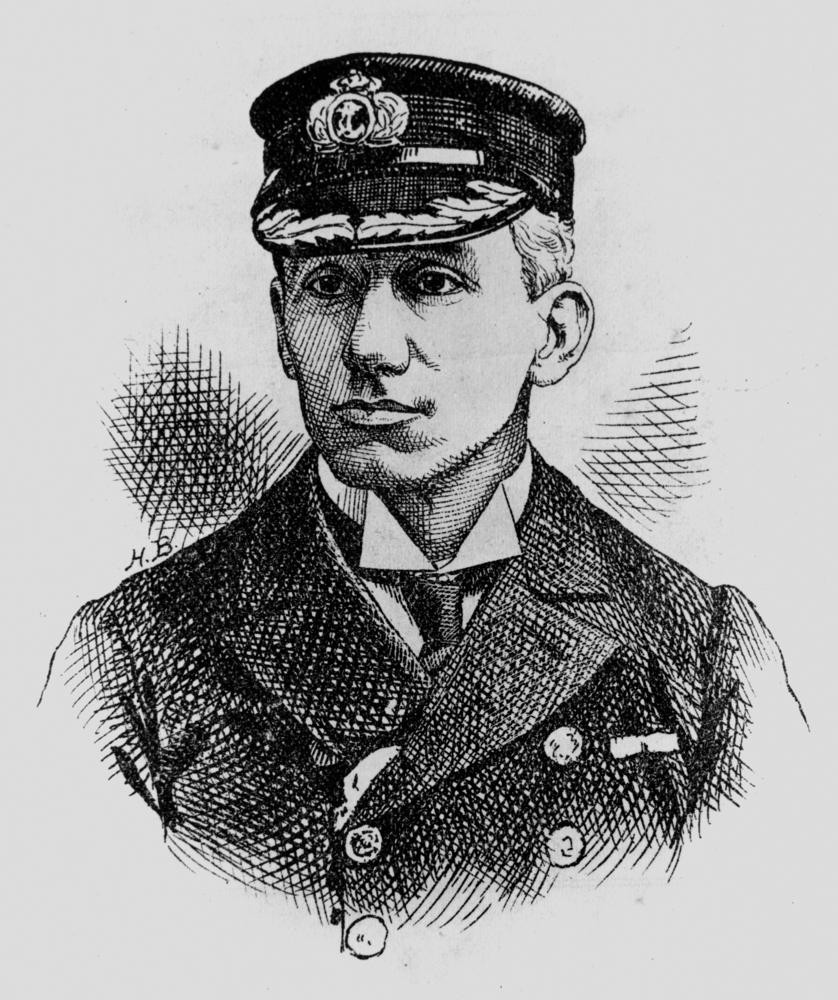
Captain Wright, R. N., 1885, John Oxley Library, State Library of Queensland Neg: 39788
On 13 October 1888 the McIlwraith government directed Captain Wright to hand over the gunboat Gayundah, together with all stores belonging to that ship, and to the various other branches of the Marine Defence Force to Lieutenant F. P. Taylor, First Lieutenant of the Gayundah. Wright responded by arresting Lieutenant Taylor and announcing his intention of hoisting the White Ensign and sailing to Sydney to report to the Rear-Admiral Cammanding-in-Chief. Wright was warned that any attempt to remove Gayundah to Sydney would result in the arrest of the gunboat by the Queensland Police. If Wright disregarded this instruction and Gayundah did proceed down the Brisbane River she would be engaged by the guns at Fort Lytton. Both sides seem to have overreacted and inflamed the situation and Wright apparently discussed with his gunner the practicality of opening fire on Parliament House! The farcical situation was lampooned in a cartoon in Queensland Figaro and Punch complete with mock lyrics in the style of a Gilbert and Sullivan operetta.
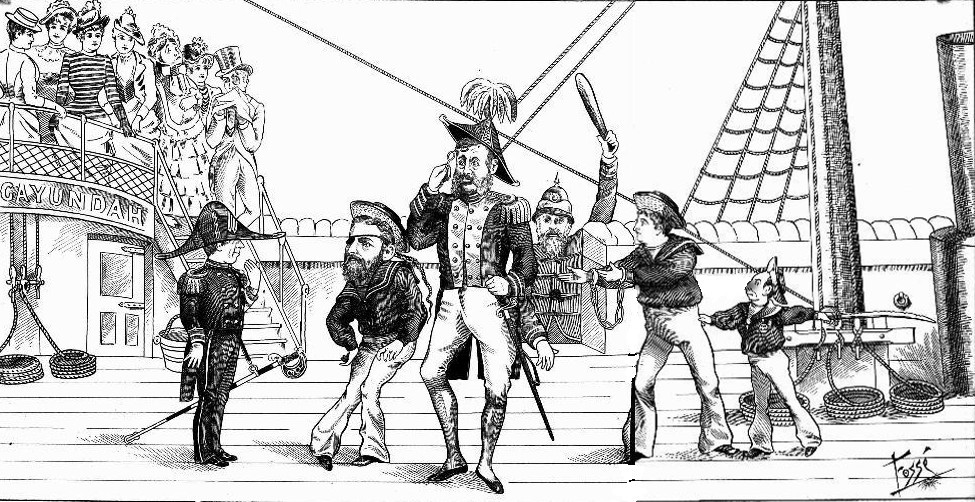
Nautical Naughtiness, Queensland Figaro and Punch, 3 November 1888
CAPTAIN CORCORAN (WRIGHT) : I am commander of the Queensland Fleet (And Captain Wright you're too) While the Ensign White I fly, I the Government defy, And I do what I please to do. My expenses I collect, And they never dare object, To the vouchers signed by me. (What, never?) No, never! (What, never?) Well - er- hardly ever.
Despite Captain Wright's protestations that he was subject only to the Admiralty the Queensland Government summarily dismissed him and refused to give him the pay under dispute or to pay for his passage back to England. The actions of the government were later proved to be correct when the British Prime Minister issued a dispatch making it clear that the Queensland Government was legally entitled to take the action it had whether the Gayundah was flying the White Ensign or not. Further embarrassment was to come in 1893 when the Paluma was left high and dry in the Botanic Gardens after the disastrous floods of that year. This was hardly the fault of the Queensland Marine Defence Force as the Paluma was then being refitted and her engines were inoperative. Some weeks later a second flood allowed Paluma to be re-floated with the aid of the government steamer Advance but embarrassing images of the grounded Paluma were widely published.
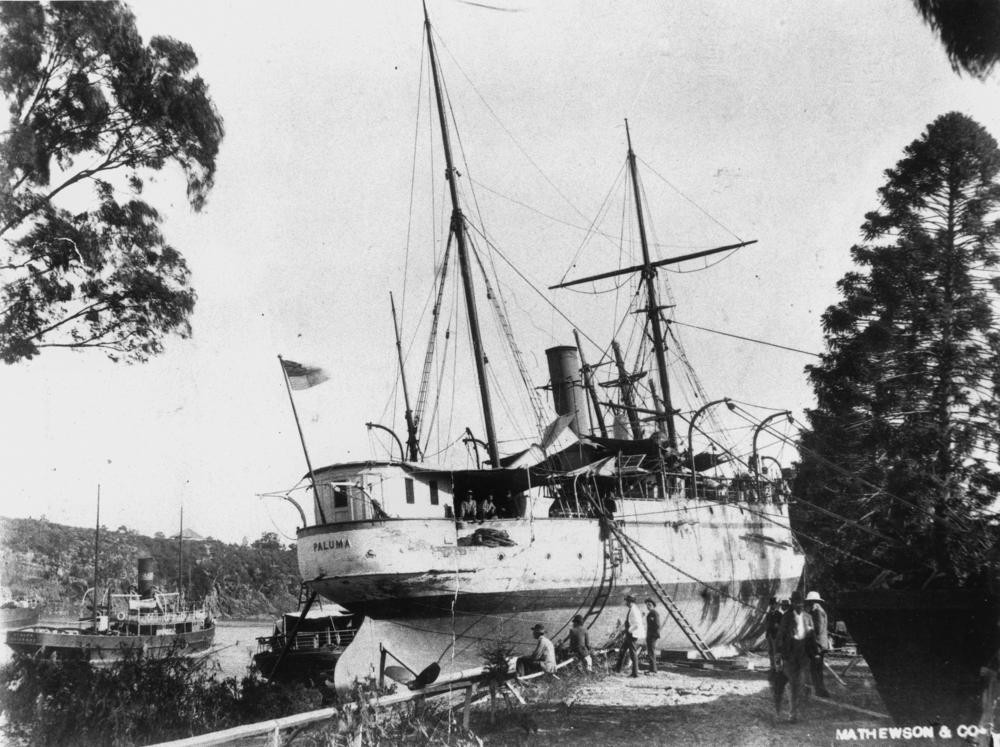
Gunboat Paluma ashore in the Brisbane Botanic Gardens, John Oxley Library, State Library of Queensland Neg: 12488
Despite these few unfortunate incidents and severe cutbacks to the Queensland defence budget during the depression of the 1890s, which threatened the disbanding of the Naval Brigades and the laying up of the gunboats, the Queensland Marine Defence Force survived and was largely restored with a new injection of funds in 1898. When, after Federation, the Commonwealth Naval Force was brought into being by the 1903 Defence Act it was Queensland's Naval Commandant, William Rooke Creswell who was appointed to command. Creswell pushed for a fully Australian manned and administered navy and when the title of Royal Australian Navy was granted in 1911 Creswell was appointed Rear-Admiral in command and promoted to Vice-Admiral in 1922. When the Commonwealth Naval Force was established close to 50% of the officers and sailors were former members of the Queensland Marine Defence Force. Former Queensland vessels also made up a large part of the new Commonwealth fleet with Gayundah, Paluma, Mosquito and the picquet boat Midge all retained in the new Australian Navy and employed for training of the Naval Brigade. It was in this new service that Gayundah fired her only shot in anger. Patrolling off the Western Australian coast, the gunboat fired a warning shot across the bows of two poaching Japanese fishing boats, capturing the two vessels and towing them to Broome.
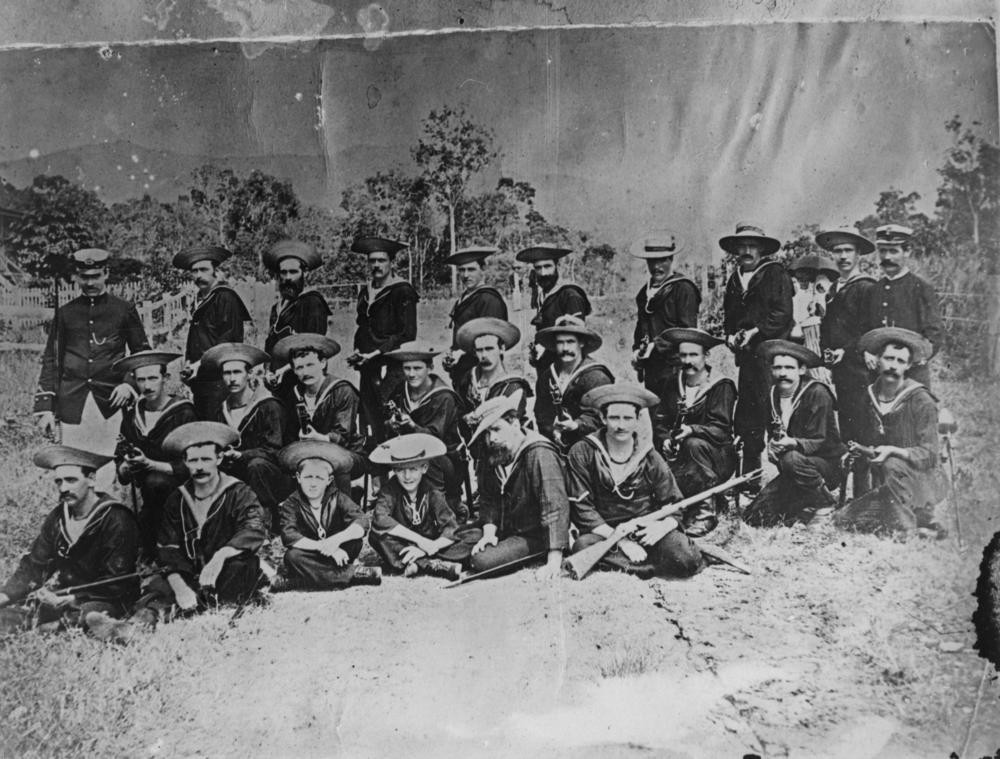
Group photograph of the Cairns Naval Brigade, ca. 1890, John Oxley Library, State Library of Queensland Neg: 70183
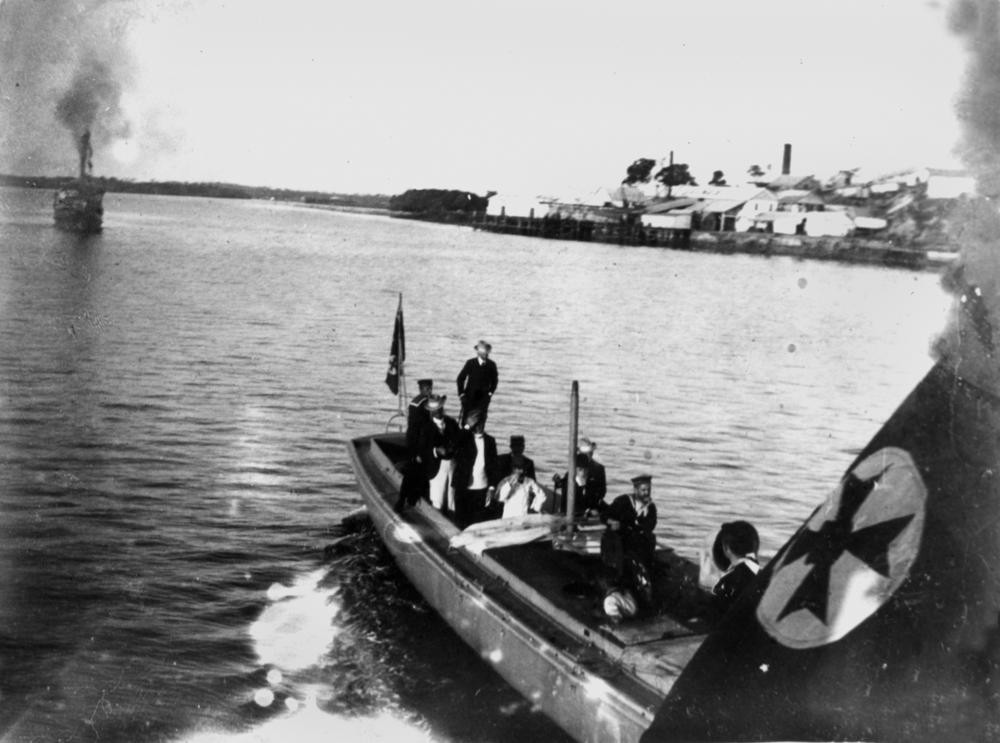
Picquet boat Midge joined the Queensland Marine Defence Force in 1887, John Oxley Library, State Library of Queensland Neg: 150137
Here are some of my other blog stories of a seafaring or piratical nature:
Bully Hayes - Pacific pirate : truth or fiction?
Burke's flaming ocean - coastal shipping in Queensland
H.M.S. Pandora : earliest recorded shipwreck on the Queensland coast
Simon Miller - Library Technician, State Library of Queensland
Comments
Your email address will not be published.
We welcome relevant, respectful comments.